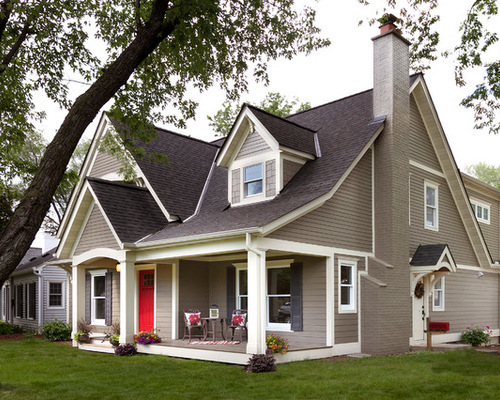There’s nothing like a fresh paint job to punch up a house’s curb appeal. And hiring a professional to do it is the best way to get a superior result — and save you the headache of ladders, repairs and other hassles.

Exterior Paint 1: Fluidesign Studio, original photo on Houzz
Project: Working with a professional on painting your house’s exterior.
Why: Whether your house is wood-frame or shingle, stucco or brick, you’ll get knowledge, accuracy and efficiency by hiring a professional.

Exterior Paint 2: Butler Armsden Architects, original photo on Houzz
Whom to hire: Many painters do both interior and exterior projects. A painting contractor should be licensed and insured. You should obtain a written contract with details about the work to be done. Review the contract to make sure it’s clear which parts of your house’s exterior are to be painted, how long the project will take and how the contractor will be paid.
Cost: A cost estimate should include all labor and materials. Additional detail work, such as painting intricate trim or repairing surface imperfections as part of the preparation work, will usually increase the cost due to the extra time required.

Exterior Paint 3: Meyer Greeson Paullin Benson (MGPB), original photo on Houzz
Costs vary by region, size of the project and amount of detail work. Jeff Dupont, of Sound Painting Solutions in Seattle, says a typical range for his medium- to large-size exterior projects (a 1,200- to 1,700- square-foot house is his medium size) is $9,000 to $12,000. Dupont says his contracts have a warranty that includes any touchups needed due to their workmanship or material defects.
How long the project will take: Prepping and painting a house’s exterior usually takes several days, depending on the size of the house. Dupont says if only minimal prep work is needed, a single-story home will take two to three days, and a two-story house two to four days.

Exterior Paint 4: PK Atkins Photography, original photo on Houzz
First steps: Many painters visit the site for a free initial consultation to talk about the scope of the project, including giving an estimate of how much it will cost and how long it will take to complete. Benjamin Moore recommends walking each potential contractor around the house, outlining which areas will be painted (siding, trim, window frames, porches, doors).
During the project: After repairing holes and cracks in stucco surfaces and using wood filler to fix frame siding, the contractor will apply a primer. Two coats of latex paint are almost always used, but in some areas, such as the Northwest, an oil-based paint might be applied to tannin-rich cedar or redwood exteriors, to better seal the wood and prevent the tannin from bleeding through the primer, Dupont says. In areas where stucco, masonry and brick homes are prevalent, a durable latex acrylic elastomeric paint might be used — it stretches if cracks form underneath.

Exterior Paint 5: Everything Home, original photo on Houzz
Before painting begins, homeowners should remove patio furniture, potted plants and other outdoor accessories in the work area. In general, painters usually remove items like hose holders and mailboxes and replace them when done. Mari Hensley, of Kennedy Painting in St. Louis, says her company asks homeowners to take any fabric cushions on patio furniture inside during the project to prevent damage.
Color considerations: Some painters provide color swatches and consultation, while others expect homeowners to research color combinations on their own. Hensley says samples can be applied to surfaces upon a homeowner’s request. Most large paint companies have online exterior color guides.

Exterior Paint 6: Polhemus Savery DaSilva, original photo on Houzz
Sherwin-Williams has color suggestions based on region and style — from traditional or contemporary suburban to desert Southwest. Behr’s Colors Gallery lets users choose from cool, neutral and warm tones.
Things to consider: A reputable professional should have all the necessary supplies, so a homeowner is not expected to provide anything. If your house was built before 1978 and lead paint is suspected, be sure your painter is certified by the Environmental Protection Agency to handle lead. Even exteriors require certain procedures if lead is detected.
Best time to do this project: Summer is the most popular time of year for painting exteriors in regions with cold, wet winters. Even in mild-weather regions, spring and summer are best for tackling exterior paint jobs. Dupont says April to October is prime time for painting exteriors in the Northwest.
 Facebook
Facebook
 X
X
 Pinterest
Pinterest
 Copy Link
Copy Link
